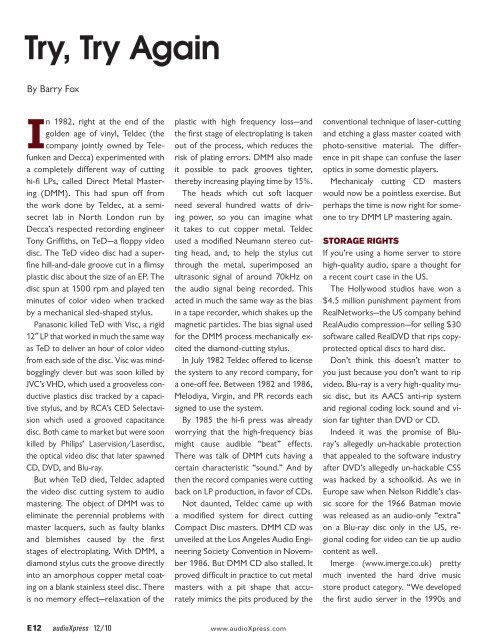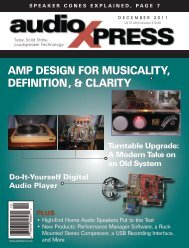A TUNE-UP FOR THE DUAL TURNTABLE - ThaiHDbox
A TUNE-UP FOR THE DUAL TURNTABLE - ThaiHDbox
A TUNE-UP FOR THE DUAL TURNTABLE - ThaiHDbox
You also want an ePaper? Increase the reach of your titles
YUMPU automatically turns print PDFs into web optimized ePapers that Google loves.
Try, Try Again<br />
By Barry Fox<br />
�n 1982, right at the end of the<br />
golden age of vinyl, Teldec (the<br />
company jointly owned by Telefunken<br />
and Decca) experimented with<br />
a completely different way of cutting<br />
hi-fi LPs, called Direct Metal Mastering<br />
(DMM). This had spun off from<br />
the work done by Teldec, at a semisecret<br />
lab in North London run by<br />
Decca’s respected recording engineer<br />
Tony Griffiths, on TeD—a floppy video<br />
disc. The TeD video disc had a superfine<br />
hill-and-dale groove cut in a flimsy<br />
plastic disc about the size of an EP. The<br />
disc spun at 1500 rpm and played ten<br />
minutes of color video when tracked<br />
by a mechanical sled-shaped stylus.<br />
Panasonic killed TeD with Visc, a rigid<br />
12� LP that worked in much the same way<br />
as TeD to deliver an hour of color video<br />
from each side of the disc. Visc was mindbogglingly<br />
clever but was soon killed by<br />
JVC’s VHD, which used a grooveless conductive<br />
plastics disc tracked by a capacitive<br />
stylus, and by RCA’s CED Selectavision<br />
which used a grooved capacitance<br />
disc. Both came to market but were soon<br />
killed by Philips’ Laservision/Laserdisc,<br />
the optical video disc that later spawned<br />
CD, DVD, and Blu-ray.<br />
But when TeD died, Teldec adapted<br />
the video disc cutting system to audio<br />
mastering. The object of DMM was to<br />
eliminate the perennial problems with<br />
master lacquers, such as faulty blanks<br />
and blemishes caused by the first<br />
stages of electroplating. With DMM, a<br />
diamond stylus cuts the groove directly<br />
into an amorphous copper metal coating<br />
on a blank stainless steel disc. There<br />
is no memory effect—relaxation of the<br />
plastic with high frequency loss—and<br />
the first stage of electroplating is taken<br />
out of the process, which reduces the<br />
risk of plating errors. DMM also made<br />
it possible to pack grooves tighter,<br />
thereby increasing playing time by 15%.<br />
The heads which cut soft lacquer<br />
need several hundred watts of driving<br />
power, so you can imagine what<br />
it takes to cut copper metal. Teldec<br />
used a modified Neumann stereo cutting<br />
head, and, to help the stylus cut<br />
through the metal, superimposed an<br />
ultrasonic signal of around 70kHz on<br />
the audio signal being recorded. This<br />
acted in much the same way as the bias<br />
in a tape recorder, which shakes up the<br />
magnetic particles. The bias signal used<br />
for the DMM process mechanically excited<br />
the diamond-cutting stylus.<br />
In July 1982 Teldec offered to license<br />
the system to any record company, for<br />
a one-off fee. Between 1982 and 1986,<br />
Melodiya, Virgin, and PR records each<br />
signed to use the system.<br />
By 1985 the hi-fi press was already<br />
worrying that the high-frequency bias<br />
might cause audible “beat” effects.<br />
There was talk of DMM cuts having a<br />
certain characteristic “sound.” And by<br />
then the record companies were cutting<br />
back on LP production, in favor of CDs.<br />
Not daunted, Teldec came up with<br />
a modified system for direct cutting<br />
Compact Disc masters. DMM CD was<br />
unveiled at the Los Angeles Audio Engineering<br />
Society Convention in November<br />
1986. But DMM CD also stalled. It<br />
proved difficult in practice to cut metal<br />
masters with a pit shape that accurately<br />
mimics the pits produced by the<br />
E12 audioXpress 12/10 www.audioXpress.com<br />
conventional technique of laser-cutting<br />
and etching a glass master coated with<br />
photo-sensitive material. The difference<br />
in pit shape can confuse the laser<br />
optics in some domestic players.<br />
Mechanicaly cutting CD masters<br />
would now be a pointless exercise. But<br />
perhaps the time is now right for someone<br />
to try DMM LP mastering again.<br />
STORAGE RIGHTS<br />
If you’re using a home server to store<br />
high-quality audio, spare a thought for<br />
a recent court case in the US.<br />
The Hollywood studios have won a<br />
$4.5 million punishment payment from<br />
RealNetworks—the US company behind<br />
RealAudio compression—for selling $30<br />
software called RealDVD that rips copyprotected<br />
optical discs to hard disc.<br />
Don’t think this doesn’t matter to<br />
you just because you don’t want to rip<br />
video. Blu-ray is a very high-quality music<br />
disc, but its AACS anti-rip system<br />
and regional coding lock sound and vision<br />
far tighter than DVD or CD.<br />
Indeed it was the promise of Bluray’s<br />
allegedly un-hackable protection<br />
that appealed to the software industry<br />
after DVD’s allegedly un-hackable CSS<br />
was hacked by a schoolkid. As we in<br />
Europe saw when Nelson Riddle’s classic<br />
score for the 1966 Batman movie<br />
was released as an audio-only “extra”<br />
on a Blu-ray disc only in the US, regional<br />
coding for video can tie up audio<br />
content as well.<br />
Imerge (www.imerge.co.uk) pretty<br />
much invented the hard drive music<br />
store product category. “We developed<br />
the first audio server in the 1990s and



